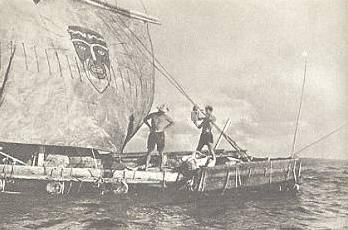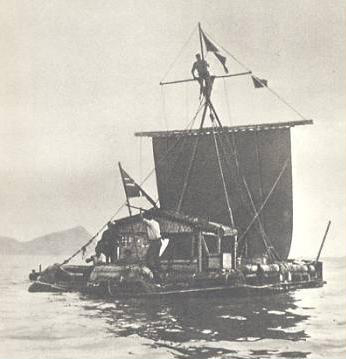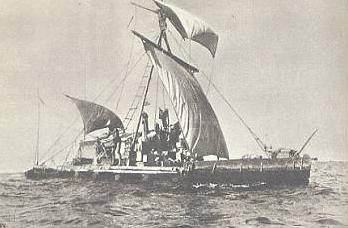Thor Heyerdahl passed away April 18, 2002, at the family home in Colla Micheri (Andora). Among the most famous contemporary Norwegian, born in 1914 in Larvik, she majored in biology, geography and anthropology, and between 1937 and 1938 lived in Polynesia, island of Fatuhiva, engaged in natural and environmental research.
It was the animator indomitable shipment of Kon-Tiki, in 1947, from Peru to Polynesia; a second crossing in 1969-70 from Safi in Morocco to Barbados on RA, papyrus boat of 15 meters, it had to stop navigating a short distance from the goal; and a second shipment of the next year with the RA II, which instead reached the goal.

The RA II depicted in the tile dedicated to the Ranger, the "wall of Alassio"
Between the late seventies and mid eighties effected numerous other navigation, all in order to demonstrate the nautical skill of the Antici surfers. In Polynesia he had reached the conviction that the ancestors of the Polynesians originated from the coasts of Latin America, as indeed confirmed ancient local legends: these were orally handed down the memory of the god-leader Tiki, son of the Sun, who had led until then his people from a distant land beyond the endless Ocean.

The bearded face of Kon-Tiki on the homonymous painted boat,
with which Heyerdahl and his companions crossed the Pacific
(From Kon-Tiki: 400 miles on a raft across the Pacific,
Milan, editor Hammer, 1965)
Heyerdahl therefore abandoned the environmental sciences and devoted himself to anthropology and archeology, to study the affinities between the peoples and cultures of Polynesia and Peru. As he says in his report of the journey of the Kon-Tiki, the Europeans claimed that they were the discoverers of those islands; in fact, even in the smallest of them had found pre-existing well-cultivated gardens, huts, temples, paved roads, ancient pyramids and huge stone statues. The population spoke an unknown language, common to the whole archipelago and not attributable to the surrounding continents. Did not know the writing, he kept - without knowing the meaning - mysterious tablets engraved with indecipherable hieroglyphics, preserved the memory of the leaders with the memory aid of a complex system of cords in knots, similar to that used by Inca.Da where, originally , then, was that people came?
Heyerdahl suggested that a first migration could be dated around A.D. 500, followed by a second in 1100. About the origin, he noted that the culture of these ancient immigrants still belonged to the Stone Age, which lasted only in the New World. Moreover, in Peru it was handed down the memory of a pre-existing mysterious population of white men, who had carved in huge boulders mountains with their stone hatchets, and had built huge walls, huge pyramids and statues: vestiges throughout similar to those found in South islands.
Those men skinned, with long beards and biodo-reddish hair, were high, wise and peaceful, experienced architects; They had come down from the north of the country and had moved its civilization to the ancestors of the Incas. Suddenly they had left Peru and had disappeared from the Pacific coast, heading West. On their arrival in the South Sea islands, Europeans had found there many natives with those same facial features accentuated by pronounced aquiline nose, who stood out among the Polynesians darker skin, eyes and jet-black hair and nose broadened and flattened. The first said to be descendants of the white gods came by sea from a distant mountainous country to the east: the legends that were handed down the memory spread throughout Polynesia. Studying the sagas of the Incas, Heyerdahl discovered that the ancient name of their god of the sun was Kon-Tiki ie "Tiki Sun", or Illa-Tiki, that "Tiki Fire", high priest and king of the founders of white men that ancient civilization. According to legend the Incas, one day they were attacked and killed by a tribe headed by Charles, came from Coquinbottal; Kon-Tiki with only a few followers escaped, fleeing by sea to the west. They are obvious connections with the Tiki Polynesian, in which stories and legends included topographical details related to the Tiki of the Incas. This first migration in the southern islands is dated by Heyerdahl to 500 AD, but throughout Polynesia he found indications that the islands were not long remained peaceful possession of the Sun line of Tiki: other tracks showed that the Colombian Indii of 'stone age, navigation experts, had arrived with their war canoes around 1100 and had merged with the people of Tiki.
The main objection raised by the theories of Heyerdahl was based on the fact that those mysterious men had no ships with which to cross the ocean: he would then show that the crossing was possible with balsa wood rafts, which they used the Aborigines Peruvians.

The Kon-Tiki on departure from the port of Callao
(From Kon-Tiki: 400 miles on a raft across the Pacific,
Milan, editor Hammer, 1965)
So it was that with five companions traveled to Peru and, after various vicissitudes, managed to build a large raft with a hut as a shelter, using only the very light wood bound with plant ropes, without the help of any metallic element.
The boat trip, pushed by the winds and by the Humoldt, lasted three months of the current in 1947, demonstrating the ability to cross the Pacific with a rudimentary vessel, and corroborated the hypothesis of Heyerdahl on striking similarities between the cultural documents and those of Polynesia the pre-Inca civilization.

To Polynesia
(From Kon-Tiki: 400 miles on a raft across the Pacific,
Milan, editor Hammer, 1965)



